Frederic Leighton
Sculptures

An athlete wrestling with a python
Paintings
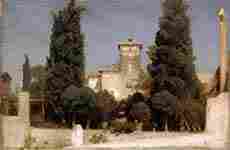
The Villa Malta, Rome
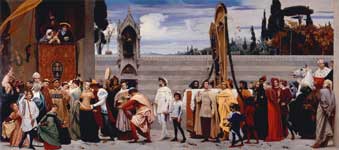
Cimabue's Celebrated Madonna is carried in Procession through the Streets of Florence
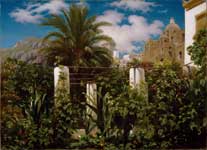
Garden of an Inn, Capri

Wedded

Perseus and Andromeda
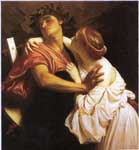
Orpheus and Eurydice
Actaea, the Nymph of the Shore
Icarus
Antigone
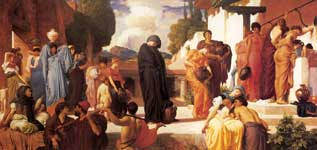
Captive Andromache
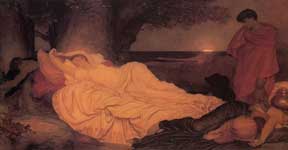
Cymon and Iphigenia

Electra at the Tomb of Agamemnon
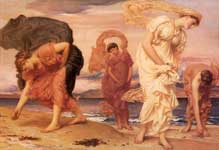
Greek Girls Picking up Pebbles by the Sea

Joseph of Arimathea
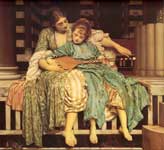
Music Lesson

Nausicaa
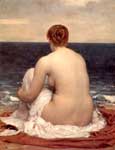
Psamathe
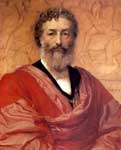
Self-portrait
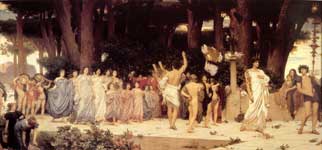
The Daphnephoria

The Fisherman and the Syren
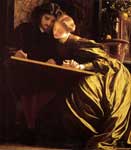
The Painter's Honeymoon

The Syracusan Bride

Venus Disrobing for the Bath
Buy Fine Art Prints | Greeting Cards | iPhone Cases
See also The Life, Letters and Work of Frederic Leighton, Volume 1, Volume 2, Mrs. Russell Barrington
Frederic Leighton, 1st Baron Leighton PRA (3 December 1830–25 January 1896), known as Sir Frederic Leighton, Bt, between 1886 and 1896, was an English painter and sculptor. His works depicted historical, biblical and classical subject matter. Leighton was bearer of the shortest-lived peerage in history; after only one day his hereditary peerage became extinct.[1]
Biography
Leighton was born in Scarborough to a family in the import and export business. He was educated at University College School, London. He then received his artistic training on the European continent, first from Eduard Von Steinle and then from Giovanni Costa. When in Florence, aged 24, where he studied at the Accademia di Belle Arti, he painted the procession of the Cimabue Madonna through the Borgo Allegri. He lived in Paris from 1855 to 1859, where he met Ingres, Delacroix, Corot and Millet.
Flaming June
In 1860, he moved to London, where he associated with the Pre-Raphaelites. He designed Elizabeth Barrett Browning's tomb for Robert Browning in the English Cemetery, Florence in 1861. In 1864 he became an associate of the Royal Academy and in 1878 he became its President (1878–96). His 1877 sculpture, Athlete Wrestling with a Python, was considered at its time to inaugurate a renaissance in contemporary British sculpture, referred to as the New Sculpture. His paintings represented Britain at the great 1900 Paris Exhibition.
Icarus and Daedalus
Leighton was knighted at Windsor in 1878, and was created a Baronet, of Holland Park Road in the Parish of St Mary Abbots, Kensington, in the County of Middlesex, eight years later.[2] He was the first painter to be given a peerage, in the New Year Honours List of 1896. The patent creating him Baron Leighton, of Stretton in the County of Shropshire, was issued on 24 January 1896;[3] Leighton died the next day of angina pectoris.
Sir Frederick Leighton in his studio in 1888
As he was unmarried, after his death his Barony was extinguished after existing for only a day; this is a record in the Peerage. His house in Holland Park, London has been turned into a museum, the Leighton House Museum. It contains a number of his drawings and paintings, as well as some of his sculptures (including Athlete Wrestling with a Python). The house also features many of Leighton's inspirations, including his collection of Iznik tiles. Its centrepiece is the magnificent Arab Hall. The Hall is featured in issue ten of Cornucopia.[4]
Timeline
1864 - Associate of the Royal Academy
1868 - Royal Academy Academician
1878 - President of the Royal Academy
1878 - Légion d'honneur Officer
1878 - Knight Bachelor
1886 - Created Baronet in the Baronetage of the United Kingdom
1889 - Associate member of the Institute of France
1896 - Created Baron in the Peerage of the United Kingdom
Selected works
Death of Brunelleschi (1852), oil on canvas
The Fisherman and the Siren, c. 1856 - 1858 (66.3 x 48.7 cm)
Cimabue's Celebrated Madonna is carried in Procession through the Streets of Florence (1853-5),[5] oil on canvas. This was his first major work and was exhibited at the Royal Academy. Queen Victoria was so taken with it that she bought it for 600 guineas on the opening day of the exhibition.
The Discovery of Juliet Apparently Lifeless (c.1858)[6]
The Villa Malta, Rome (1860s),[7] oil on canvas
The Painter's Honeymoon, c. 1864 (83.8 x 77.5 cm)
Mother and Child, c. 1865, (48.2 x 82 cm)
Actaea, the Nymph of the Shore (1868),[8] oil on canvas, (57.2 x 102.2 cm) National Gallery of Canada, Ottawa.
Daedalus and Icarus, c. 1869, (138.2 x 106.5 cm)
Hercules Wrestling with Death for the Body of Alcestis (1869–71) (132.4 x 265.4 cm)
Greek Girls Picking up Pebbles by the Sea, 1871 (84 x 129.5 cm)
Teresina (circa 1874) Christchurch Art Gallery Te Puna o Waiwhetu, Christchurch, New Zealand
Music Lesson, c. 1877, (92.8 x 118.1 cm)
An Athlete Wrestling with a Python (1877),[9] bronze sculpture
Nausicaa, c. 1878 (145 x 67 cm)
Winding the Skein, c. 1878, (100.3 x 161.3 cm)
Light of the Harem, c. 1880, (152.4 x 83.8 cm)
Wedded, (c. 1881 - 1882) (145.4 x 81 cm)
Captive Andromache, c. 1888 (197 x 406.5 cm)
The Bath of Psyche, (c. 1889−90) (189.2 x 62.2 cm) Tate Gallery
The Garden of the Hesperides, c. 1892, (169 x 169 cm)
Flaming June (1895), oil on canvas, Museo de Arte de Ponce, Puerto Rico (120.6 x 120.6 cm)
The Parable of the Wise and Foolish Virgins (Fresco)[10]
The armlet
Phoebe (55.88 x 60.96 cm)
A Bather
The Leighton Frescoes, The Arts of Industry as Applied to War and The Arts of Industry as Applied to Peace
See also
Frederic Lord Leighton , Ernest Rhys
References
1. ^ Peerage records - Leigh Rayment's Peerage Page
2. ^ London Gazette: no. 25551, p. 328, 22 January 1886.
3. ^ London Gazette: no. 26705, p. 587, 31 January 1896.
4. ^ http://www.cornucopia.net/highlights10full.html
5. ^ http://www.nationalgallery.org.uk/cgi-bin/WebObjects.dll/CollectionPublisher.woa/wa/work?workNumber=L275
6. ^ http://www.tate.org.uk/servlet/ViewWork?cgroupid=999999961&workid=8581&searchid=6933&tabview=image
7. ^ http://www.nationalgallery.org.uk/cgi-bin/WebObjects.dll/CollectionPublisher.woa/wa/work?workNumber=L851
8. ^ http://cybermuse.gallery.ca/cybermuse/search/artwork_e.jsp?mkey=10042
9. ^ http://www.tate.org.uk/servlet/ViewWork?cgroupid=999999961&workid=8579&searchid=6933&tabview=image
10. ^ http://www.newforestparishes.com/page8/page2/files/page2_1.jpg
Retrieved from "http://en.wikipedia.org/ ", Text is available under the Creative Commons Attribution-ShareAlike License
Art Books
